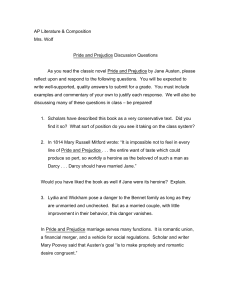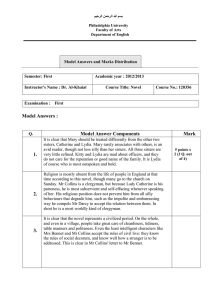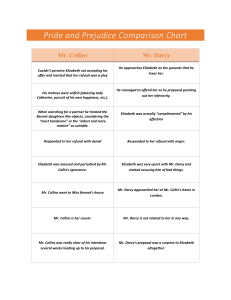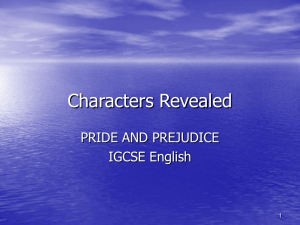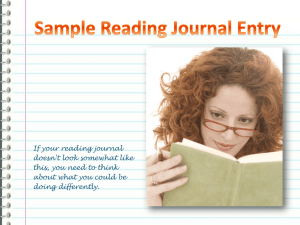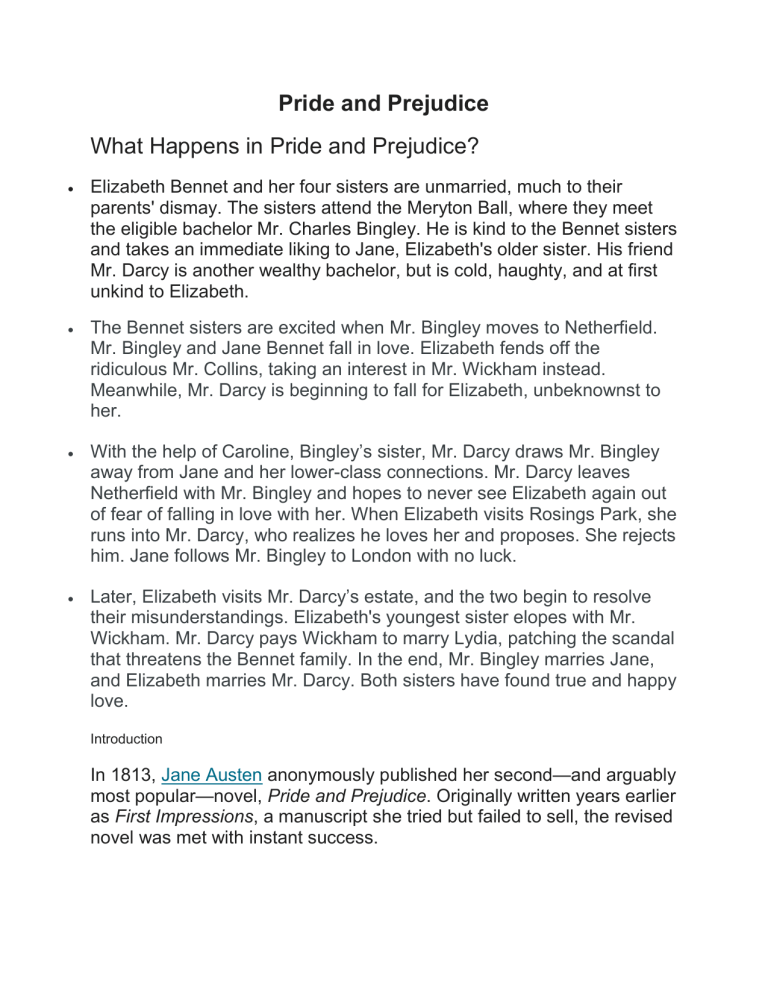
Pride and Prejudice What Happens in Pride and Prejudice? Elizabeth Bennet and her four sisters are unmarried, much to their parents' dismay. The sisters attend the Meryton Ball, where they meet the eligible bachelor Mr. Charles Bingley. He is kind to the Bennet sisters and takes an immediate liking to Jane, Elizabeth's older sister. His friend Mr. Darcy is another wealthy bachelor, but is cold, haughty, and at first unkind to Elizabeth. The Bennet sisters are excited when Mr. Bingley moves to Netherfield. Mr. Bingley and Jane Bennet fall in love. Elizabeth fends off the ridiculous Mr. Collins, taking an interest in Mr. Wickham instead. Meanwhile, Mr. Darcy is beginning to fall for Elizabeth, unbeknownst to her. With the help of Caroline, Bingley’s sister, Mr. Darcy draws Mr. Bingley away from Jane and her lower-class connections. Mr. Darcy leaves Netherfield with Mr. Bingley and hopes to never see Elizabeth again out of fear of falling in love with her. When Elizabeth visits Rosings Park, she runs into Mr. Darcy, who realizes he loves her and proposes. She rejects him. Jane follows Mr. Bingley to London with no luck. Later, Elizabeth visits Mr. Darcy’s estate, and the two begin to resolve their misunderstandings. Elizabeth's youngest sister elopes with Mr. Wickham. Mr. Darcy pays Wickham to marry Lydia, patching the scandal that threatens the Bennet family. In the end, Mr. Bingley marries Jane, and Elizabeth marries Mr. Darcy. Both sisters have found true and happy love. Introduction In 1813, Jane Austen anonymously published her second—and arguably most popular—novel, Pride and Prejudice. Originally written years earlier as First Impressions, a manuscript she tried but failed to sell, the revised novel was met with instant success. Despite Pride and Prejudice’s 19th-century setting, its biting wit, sharp eye for the nuances of human relationships, and opposites-attract romance continues to resonate with contemporary readers. The novel has become a fixture in popular culture and has been adapted into countless films, plays, and television series. Even people who don’t know the details of the plot are probably familiar with the novel’s famous opening line: “It is a truth universally acknowledged, that a single man in possession of a good fortune, must be in want of a wife.” The novel’s main characters, Elizabeth Bennet and Fitzwilliam Darcy, meet at a village ball, where they don’t interact directly but form negative opinions of each other. Darcy dismisses Elizabeth as shallow and uninteresting, while Elizabeth deems Darcy arrogant and rude. As each struggles with mismatched suitors, friendship woes, and family drama, their lives become more intertwined and their relationship shifts from one of mutual loathing to one of mutual respect and love—and they learn that first impressions aren’t always reliable. Plot Summary When rich bachelor Mr. Charles Bingley moves to the English town of Meryton, one longtime resident, Mrs. Bennet, plots how to get him to marry one of her five daughters—Jane, Elizabeth, Mary, Catherine, and Lydia—much to the annoyance of her inattentive husband, Mr. Bennet. Her eagerness is not unwarranted, however: single women of middle-class status like the Bennets were not allowed to inherit money or property at the time. If the Bennet sisters did not find suitable and financially-secure husbands, they would likely become poor spinsters. The opportunity for the Bennet sisters to meet Mr. Bingley arrives in the form of a ball held in town. Bingley dances with Jane and suggests that his friend Mr. Darcy dance too. But Darcy refuses and insults most of the women in attendance, including Elizabeth, in the process. Gossip has spread about Mr. Darcy’s wealth, which is much greater than Mr. Bingley’s. At first, Mrs. Bennet and those at the ball respect him, but after seeing his manner and refusal to... (The entire section is 1,516 words.) Pride and Prejudice Homework Help Questions What literary effects are in Pride and Prejudice by Jane Austen? Interestingly, "literary effects" is used four different ways in literary discussion. Literary effect is: synonymous with "literary devices" the effects of something external on contemporaneous... What is the short summary of Pride and Prejudice? A short summary of Pride and Prejudice may cause Jane Austen to groan aloud, but I'll try. Five daughters of a country gentleman who married for beauty and lived to regret it, are enticed by their... What is a short summary of Pride and Prejudice? In brief, Pride and Prejudice is all about love. The title refers to the main characters, Elizabeth Bennet and Mr. Darcy. The proud Mr. Darcy insults the lively Elizabeth at a ball, saying she's... Why read Pride and Prejudice? My experience as a high school English teacher has been that students find certain texts “boring” because of the language they are written in. P & P was written long ago and is in quite... Can someone can help me with my reading report on "Pride and Prejudice"?Original question:... Your first step in writing your reading report is to make an outline of the general topics you intend to cover. Then, as you read through the book, you can fill in the details for each section of... Pride and Prejudice A romantic novel by Jane Austen, published anonymously in three volumes in 1813. A classic of English literature, written with incisive wit and superb character delineation, it centres on the turbulent relationship between Elizabeth Bennet, the daughter of a country gentleman, and Fitzwilliam Darcy, a rich aristocratic landowner. Summary Pride and Prejudice is set in rural England in the early 19th century, and it follows the Bennet family, which includes five very different sisters. Mrs. Bennet is anxious to see all her daughters married, especially as the modest family estate is to be inherited by William Collins when Mr. Bennet dies. At a ball, the wealthy and newly arrived Charles Bingley takes an immediate interest in the eldest Bennet daughter, the beautiful and shy Jane. The encounter between his friend Darcy and Elizabeth is less cordial. Although Austen shows them intrigued by each other, she reverses the convention of first impressions: pride of rank and fortune and prejudice against the social inferiority of Elizabeth’s family hold Darcy aloof, while Elizabeth is equally fired both by the pride of self-respect and by prejudice against Darcy’s snobbery. The pompous Collins subsequently arrives, hoping to marry one of the Bennet sisters. Elizabeth, however, refuses his offer of marriage, and he instead becomes engaged to her friend Charlotte Lucas. During this time, Elizabeth encounters the charming George Wickham, a military officer. There is a mutual attraction between the two, and he informs her that Darcy has denied him his inheritance. After Bingley abruptly departs for London, Elizabeth’s dislike of Darcy increases as she becomes convinced that he is discouraging Bingley’s relationship with Jane. Darcy, however, has grown increasingly fond of Elizabeth, admiring her intelligence and vitality. While visiting the now-married Charlotte, Elizabeth sees Darcy, who professes his love for her and proposes. A surprised Elizabeth refuses his offer, and, when Darcy demands an explanation, she accuses him of breaking up Jane and Bingley. Darcy subsequently writes Elizabeth a letter in which he explains that he separated the couple largely because he did not believe Jane returned Bingley’s affection. He also discloses that Wickham, after squandering his inheritance, tried to marry Darcy’s then 15-year-old sister in an attempt to gain possession of her fortune. With these revelations, Elizabeth begins to see Darcy in a new light. Shortly thereafter the youngest Bennet sister, Lydia, elopes with Wickham. The news is met with great alarm by Elizabeth, since the scandalous affair— which is unlikely to end in marriage—could ruin the reputation of the other Bennet sisters. When she tells Darcy, he persuades Wickham to marry Lydia, offering him money. Despite Darcy’s attempt to keep his intervention a secret, Elizabeth learns of his actions. At the encouragement of Darcy, Bingley subsequently returns, and he and Jane become engaged. Finally, Darcy proposes again to Elizabeth, who this time accepts. Analysis The work, which Austen initially titled First Impressions, is the second of four novels that Austen published during her lifetime. Although Pride and Prejudice has been criticized for its lack of historical context, the existence of its characters in a social bubble that is rarely penetrated by events beyond it is an accurate portrayal of the enclosed social world in which Austen lived. She depicted that world, in all its own narrow pride and prejudice, with unswerving accuracy and satire. At the same time, she placed at its centre, as both its prime actor and most perceptive critic, a character so well conceived and rendered that the reader cannot but be gripped by her story and wish for its happy dénouement. In the end, Austen’s novel has remained popular largely because of Elizabeth—who was reportedly Austen’s own favourite among all her heroines—and because of the enduring appeal to men and women alike of a well-told and potentially happily ending love story. Pride and Prejudice inspired various stage, film, and television productions. One of its most notable adaptations was a 1995 TV miniseries starring Jennifer Ehle (Elizabeth) and Colin Firth (Darcy).
